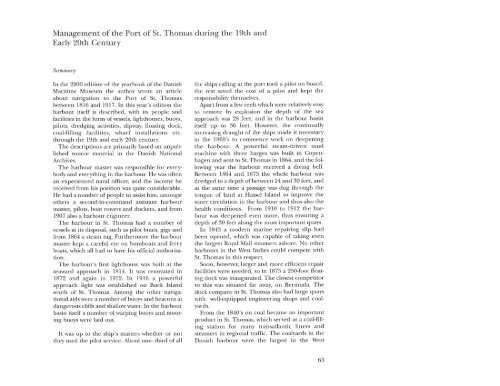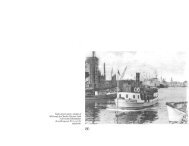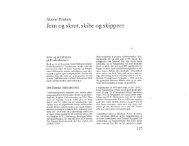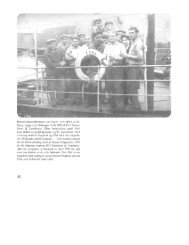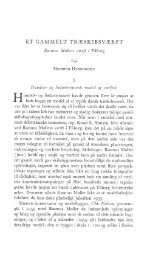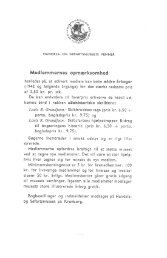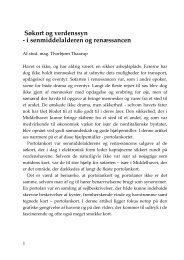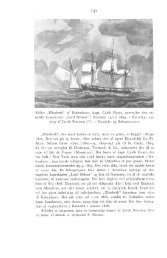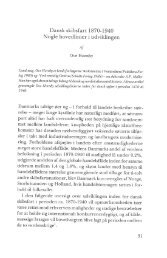Sankt Thomas havn i det 19 - Handels- og Søfartsmuseet
Sankt Thomas havn i det 19 - Handels- og Søfartsmuseet
Sankt Thomas havn i det 19 - Handels- og Søfartsmuseet
Create successful ePaper yourself
Turn your PDF publications into a flip-book with our unique Google optimized e-Paper software.
Management of the Port of St. <strong>Thomas</strong> during the <strong>19</strong>th and<br />
Early 20th Century<br />
Summary<br />
In the 2000 edition of the yearbook of the Danish<br />
Maritime Museum the author wrote an article<br />
about navigation to the Port of St. <strong>Thomas</strong><br />
between 1816 and <strong>19</strong>17. In this year's edition the<br />
harbour itself is described, with its people and<br />
facilities in the form of vessels, lighthouses, buoys,<br />
pilots, dredging activities, slipway, floating dock,<br />
coal-filling facilities, wharf installations etc.<br />
through the <strong>19</strong>th and early 20th century.<br />
The descriptions are primarily based on unpublished<br />
source material in the Danish National<br />
Archives.<br />
The harbour master was responsible for everybody<br />
and everything in the harbour. He was often<br />
an experienced naval officer, and the income he<br />
received from his position was quite considerable.<br />
He had a number of people to assist him, amongst<br />
others a second-in-command assistant harbour<br />
master, pilots, boat rowers and dockers, and from<br />
<strong>19</strong>07 also a harbour engineer.<br />
The harbour in St. <strong>Thomas</strong> had a number of<br />
vessels at its disposal, such as pilot boats, gigs and<br />
from 1864 a steam tug. Furthermore the harbour<br />
master kept a careful eye on bumboats and ferry<br />
boats, which all had to have his official authorisation.<br />
The harbour's first lighthouse was built at the<br />
seaward approach in 1814. It was renovated in<br />
1872 and again in <strong>19</strong>12. In <strong>19</strong>16 a powerful<br />
approach light was established on Buck Island<br />
south of St. <strong>Thomas</strong>. Among the other navigational<br />
aids were a number of buoys and beacons at<br />
dangerous cliffs and shallow water. In the harbour<br />
basin itself a number of warping buoys and mooring<br />
buoys were laid out.<br />
It was up to the ship's masters whether or not<br />
they used the pilot service. About one- third of all<br />
the ships calling at the port took a pilot on board,<br />
the rest saved the cost of a pilot and kept the<br />
responsibility themselves.<br />
Apart from a few reefs which were relatively easy<br />
to remove by explosion the depth of the sea<br />
approach was 28 feet, and in the harbour basin<br />
itself up to 36 feet. However, the continually<br />
increasing draught of the ships made it necessary<br />
in the 1860's to commence work on deepening<br />
the harbour. A powerful steam-driven mud<br />
machine with three barges was built in Copenhagen<br />
and sent to St. <strong>Thomas</strong> in 1864, and the following<br />
year the harbour received a diving bell.<br />
Between 1864 and 1873 the whole harbour was<br />
dredged to a depth of between 24 and 30 feet, and<br />
at the same time a passage was dug through the<br />
tongue of land at Hassel Island to improve the<br />
water circulation in the harbour and thus also the<br />
health conditions. From <strong>19</strong>10 to <strong>19</strong>12 the harbour<br />
was deepened even more, thus ensuring a<br />
depth of 30 feet along the most important quays.<br />
In 1843 a modern marine repairing slip had<br />
been opened, which was capable of taking even<br />
the largest Royal Mail steamers ashore. No other<br />
harbours in the West Indies could compete with<br />
St. <strong>Thomas</strong> in this respect.<br />
Soon, however, larger and more efficient repair<br />
facilities were needed, so in 1875 a 250-foot floating<br />
dock was inaugurated. The closest competitor<br />
to this was situated far away, on Bermuda. The<br />
dock company in St. <strong>Thomas</strong> also had large quays<br />
with well-equipped engineering shops and coalyards.<br />
From the 1840's on coal became an important<br />
product in St. <strong>Thomas</strong>, which served as a coal-filling<br />
station for many transatlantic liners and<br />
steamers in regional traffic. The coalyards in the<br />
Danish harbour were the largest in the West<br />
63


